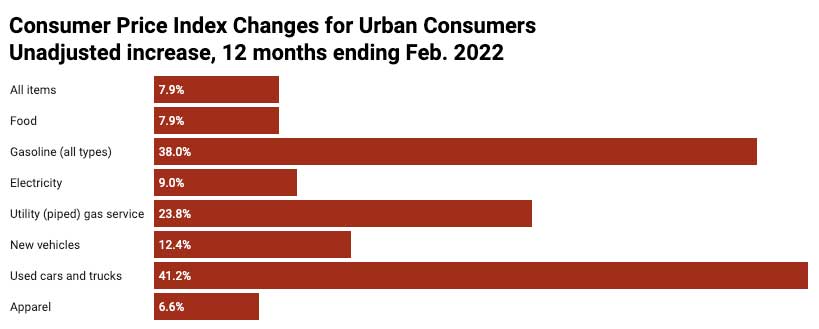According to last week’s report from the Bureau of Labor Statistics, the rate of inflation in the U.S. reached almost 8 percent in February, a 40-year high. The Russian invasion of Ukraine has added new uncertainty to how long this trend might continue, with effects beyond rising oil prices. Unexpected COVID-19 surges in China have prompted lockdowns in industrial hubs, exacerbating existing concerns about supply chains.
As has been the case with other pandemic disruptions, this has had the greatest impact on Americans with the fewest resources. An analysis by the University of Pennsylvania’s Wharton School found that while higher-income households saw earnings rise faster than the cost of living, earnings in the lowest-income households went up by only a third of their increased costs from inflation.
A long-accepted standard for housing affordability is that housing costs should not exceed 30 percent of household income, but almost half of all renters were already paying more than that before the pandemic. Some have suggested that 40 percent might be a more appropriate standard, but doing the math to support this is difficult when the prices of so many things are in flux.
A January Pew survey found that almost five in 10 Americans consider the lack of affordable housing in their communities to be a “major problem,” almost twice as many as those who see the health impacts of COVID-19 with the same level of concern. (California’s Little Hoover Commission found a surprising connection between these two things, estimating that approximately two-thirds of Californians living in overcrowded housing either are essential workers or live with one.)

Source: BLS Created with Datawrapper
For decades, the price of new homes has increased at a much faster pace than household income. The lack of supply is a major factor in this disparity.
“We have underbuilt for at least 10 years now,” says Jonathan Reckford, CEO of Habitat for Humanity. “Depending on whose numbers you pick, we are between 3.8 and six million units short.”
Founded almost 50 years ago by Clarence Jordan, a farmer and biblical scholar, Habitat works in all 50 U.S. states and more than 70 countries. Reckford became its CEO in 2005, after working as a financial analyst and executive for corporations including Disney and Best Buy.
Reckford spoke with Governing about the tensions now at play in the U.S. housing market and outlined some of the things the public sector can do to ease them. These strategies are discussed in detail in Habitat’s Cost of Home campaign. The interview has been edited for length and clarity.

Chart: Governing Source: FRED Created with Datawrapper
Governing: How much is historic inflation making something that was already bad even worse?
Jonathan Reckford: Even pre-COVID, you had one in seven families paying over half their income on rent or mortgage. In historically affordable markets, prices have accelerated so quickly, and so much faster than incomes, that housing is just further out of reach.
I’ve heard story after story from Habitat affiliates of rent increases as much as 15 to 30 percent on renewals. If your rent goes up by these numbers, you’re making horrible choices to give up funding for food security, health care, education and all the other things that families need and want.
If you can bring good out of bad, I’ve heard more talk about housing in the past 12 months than in the past 12 years because it’s gotten to such an urgent state.
Governing: How can property owners justify increases when families are so stressed?
Jonathan Reckford: There’s an opportunistic element, and there’s a cost element — the landlord’s costs have been rising as well.
The biggest macro challenge is lack of supply. It’s really hard to drive down inflation because about a third of the inflation costs come from housing. I think we’ve only begun to see the housing increases fully ramp in, so we’re going to see more inflation just from housing.
Governing: Housing has the aspect of an individual problem, but how does an affordability crisis hurt the whole community?
Jonathan Reckford: There’s deep research that shows the correlation between housing and health, and housing and education and stability for children. All these pieces are interrelated and if you pull housing out, none of the other pieces work very well.
There are two things that have not worked in our society. One is that we have concentrated poverty. The other is that people have moved an hour away, two hours away, to find something that they can afford. That’s bad for everybody, bad for the environment as well as for the families.
Governing: How does this relate to Habitat’s emphasis on communities of opportunity?

Jonathan Reckford: “If you can bring good out of bad, I’ve heard more talk about housing in the past 12 months than in the past 12 years because it’s gotten to such an urgent state.” (Habitat for Humanity International)
Jonathan Reckford: We know that mixed income, mixed use is really the best answer for all of society. Low-income children who live in mixed communities have relatively good social mobility; the American dream still works. A wealth of studies have shown that if low-income children grow up in concentrated poverty, it takes a minor miracle for them to move to the middle class.
Could you grow up in a community of opportunity, with access? Could you live close to where you work, which is better for quality life and health communities? Historically, cities were designed that way. It’s a relatively recent phenomenon that we have created this economic segregation and a racial segregation that correlates with that.
Everybody wins if we have better design.
Governing: What’s holding things back?
Jonathan Reckford: My hypothesis is that one reason the problem is not more viscerally apparent is economic segregation. Most people in positions of influence have not experienced the lack of good housing.
In some ways, it’s become a more visible crisis because the children of middle-class parents suddenly can’t afford housing. What most people still don’t see are all the people living in a garage, living in overcrowded conditions and paying very high percentages of their income for rent. In Northern and Southern California, high percentages of homeless people have good jobs — they just can’t afford housing.
There’s nothing easy about increasing supply, but if we only use demand solutions and we don’t increase housing supply, we’re going to keep squeezing and forcing up prices.
Governing: Where should state and local governments focus their efforts?
Jonathan Reckford: We need to create the right set of carrots and sticks. If you’re a good-hearted builder — and Habitat is as good-hearted a builder as you will find anywhere — you cannot build something that is affordable for a low-wage individual or family without subsidy. We have to find subsidy in either land or financing.
Many states have housing finance agencies. There are good examples at the local and state level of creating housing trust funds that start to create a regular stream of funding.
It’s not only the dollars. The other sides are zoning and regulation and land use.
Governing: What are examples of zoning or regulatory changes that are needed?
Jonathan Reckford: We’ve got to change zoning so we can create mixed-income communities. At the local level, the goal would be to invest in historically underinvested communities. An important local thing that could be reinforced by the state would be making it easier to build more density along transit lines and transit routes, not necessarily high rises, and making sure that density is mixed income. Accessory dwelling units are a soft way to increase density and supply.
Second would be looking hard at the permitting and entitlements process and trying to streamline that, and lower the fees. Maybe that’s where the carrot could be; if you’re building for low- and moderate- income families, you get a reduction in your entitlement fees.
Can we take it from 39 steps to six steps to get to approval? Can we shorten it from a two-year approval process to a three-month approval process? That’s worth money.
Governing: What about land?
Jonathan Reckford: Many cities and counties still own a significant amount of land. Allocate for affordable housing. Through land banks or restricted covenants you could make sure you have long-term affordability on that land, whether it’s home ownership or rental. When you look at fast-growing cities, the ones that didn’t allocate land in advance for housing are the ones that choke.
None of this is easy, but these are levers that would help.
Governing: What’s the potential return for cities that make these kinds of efforts?
Jonathan Reckford: The timing is extraordinarily strong. Housing is a wonderful multiplier from an economic growth perspective.
If a city is sitting on land and turns that land into housing, that is a job creator and a future tax creator. The fast-growing cities right now are the ones that historically had relatively low-cost housing.
You can’t stop people from moving to communities where the jobs are, but at some point the lack of housing constrains growth. School districts are realizing they’re going to have to start creating housing because their teachers can’t afford to live in their community.
The nice thing is that if you build more housing, you create economic growth while mitigating inflation. That solves two critical problems.
Governing: How does stimulus funding fit into the picture?
Jonathan Reckford: There’s an ocean of federal money that still hasn’t been spent that could be allocated toward housing. That’s a very near-term, direct opportunity.
Make sure that Community Development Block Grant funds go to housing. We would argue that some of that should go to home ownership because that creates stability.
Not everybody should be homeowners, but suddenly we’ve locked an entire generation out and there’s a huge cost from that. And so much of the wealth gap is explained by people who are able to own homes and those who are not.
Governing: We’ve just been through a historic public health emergency. What does housing supply have to do with health?
Jonathan Reckford: It’s a great example of how cities and states don’t budget well. On the one hand, they increase their health budget by 30 percent, but they don’t recognize that if they spend a little bit on housing, they could dramatically lower their health costs.
The reason hospitals are investing in people experiencing homelessness is it will lower their costs. There have been some really creative partnerships.
Governing: Stakeholders haven’t always agreed about COVID-19 response, but there is more consensus about the path to economic recovery. Where does housing fit in all this?
Jonathan Reckford: Historically, housing has been a bipartisan issue. We are eternally optimistic or we wouldn’t do this work.
It’s an important time for both parties to think about how we can get together and solve this.
Republished with permission from Governing Magazine, by Carl Smith

Governing
Governing: The Future of States and Localities takes on the question of what state and local government looks like in a world of rapidly advancing technology. Governing is a resource for elected and appointed officials and other public leaders who are looking for smart insights and a forum to better understand and manage through this era of change.
